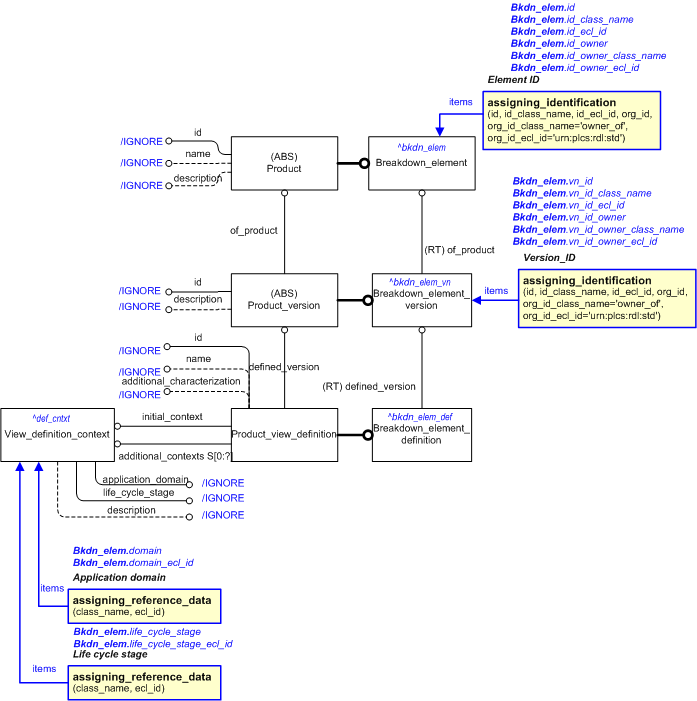Template:— referencing_breakdown_element (ref_bkdn_elem)
Capability:representing_breakdown_structure |
Date: 2009/03/11 08:59:17
Revision: 1.3
|
This section specifies the template referencing_breakdown_element.
NOTE
The template has been defined in the context of the capability
representing_breakdown_structure
which provides an overall description of the
relevant parts of the ISO 10303-239 information model and a description
of related templates.
NOTE
An explanation of a template and the associated instantiation path is
provided in the
Template overview
section.
The EXPRESS-G diagram in
Figure
1
shows the templates and EXPRESS entities that are required
to represent the template
"referencing_breakdown_element".
The text highlighted in blue shows the template parameters.
![[warning:]](../../../../images/dex/warning.gif) Error model_diag_1: Either delete A DESCRIPTION OF THE DIAGRAM or provide a description
Error model_diag_1: Either delete A DESCRIPTION OF THE DIAGRAM or provide a description
A DESCRIPTION OF THE DIAGRAM
Figure 1 — An EXPRESS-G representation of the Information model for referencing_breakdown_element
The graphic for the template to be used in other EXPRESS-G diagrams
is shown in Figure
2
below.
![[warning:]](../../../../images/dex/warning.gif) Error model_diag_1: Either delete A DESCRIPTION OF THE DIAGRAM or provide a description
Error model_diag_1: Either delete A DESCRIPTION OF THE DIAGRAM or provide a description
A DESCRIPTION OF THE DIAGRAM
Figure 2 — The graphical representation of the referencing_breakdown_element template
The following input parameters are defined for this template:
id_class_name (Default=Breakdown_element_identification_code,Type='CLASS')
The name of the class being used to classify the
(
Identification_assignment)
of the breakdown_element. This provides the role or reason for the identification.
The following classes and their sub-classes can be used:
id_ecl_id (Default=urn:plcs:rdl:std,Type='URN')
The identifier of the
External_class_library
storing the definition of the class referenced by the parameter @id_class_name class.
The name or identifier of the organization owning the id or name.
The name of the class being used to classify the
identification of the organization. For example CAGE code, or organization name.
The following classes and their sub-classes can be used:
vn_id (Default=/NULL,Type='STRING')
The name of the class being used to classify the identification
(
Identification_assignment)
of the breakdown_element_version. This provides the role or reason for the identification.
The following classes and their sub-classes can be used:
The identifier of the
External_class_library
storing the definition of the class referenced by the parameter @vn_id_class_name class.
The name or identifier of the organization owning the version_id.
The name of the class being used to classify the
identification of the organization. For example CAGE code, or organization name.
The following classes and their sub-classes can be used:
The following classes and their sub-classes can be used:
The identifier of the
External_class_library
storing the definition of the class referenced by the parameter @life_cycle_stage class.
domain (Default=Application_domain,Type='CLASS')
The following classes and their sub-classes can be used:
The identifier of the
External_class_library
storing the definition of the class referenced by the parameter @domain class.
The following reference parameters are defined for this template:
Allow the
Breakdown_element
entity instantiated in this path to be referenced when this template is used.
%^target = $referencing_breakdown_element.bkdn_elem%
%^target = $referencing_breakdown_element.bkdn_elem_vn%
%^target = $referencing_breakdown_element.bkdn_elem_def%
%^target = $referencing_breakdown_element.def_cntxt%
The instantiation path shown below specifies the entities that are to be
instantiated by the template.
A description of templates and the syntax for the instantiation path is
provided in the
Templates Help/Information section.
-- instantiate Breakdown_element Breakdown_element%^bkdn_elem =
Breakdown_element%
^bkdn_elem.id = '/IGNORE'
^bkdn_elem.name = '/IGNORE'
^bkdn_elem.description = '/IGNORE'
-- assign ID to breakdown_element /
assigning_identification(
id=@id,
id_class_name=@id_class_name,
id_ecl_id=@id_ecl_id,
org_id=@id_owner,
org_id_class_name=@id_owner_class_name,
org_id_ecl_id=@id_owner_ecl_id,
items=^bkdn_elem)/
-- instantiate Breakdown_element_version Breakdown_element_version%^bkdn_elem_vn =
Breakdown_element_version%
^bkdn_elem_vn.id = '/IGNORE'
^bkdn_elem_vn.description = '/IGNORE'
^bkdn_elem_vn.of_product ->
^bkdn_elem
-- assign ID to Breakdown_element_version /
assigning_identification(
id=@vn_id,
id_class_name=@vn_id_class_name,
id_ecl_id=@vn_id_ecl_id,
org_id=@vn_id_owner,
org_id_class_name=@vn_id_owner_class_name,
org_id_ecl_id=@vn_id_owner_ecl_id,
items=^bkdn_elem_vn)/
-- instantiate Breakdown_element_definition Breakdown_element_definition%^bkdn_elem_def =
Breakdown_element_definition%
^bkdn_elem_def.id = '/IGNORE'
^bkdn_elem_def.name = '/IGNORE'
^bkdn_elem_def.additional_characterization = '/IGNORE'
^bkdn_elem_def.defined_version ->
^bkdn_elem_vn
-- instantiate View_definition_context and bind it to the Breakdown_element_definition
^bkdn_elem_def.initial_context ->
View_definition_context%^def_cntxt =
View_definition_context%
^def_cntxt.life_cycle_stage = '/IGNORE'
^def_cntxt.application_domain = '/IGNORE'
^def_cntxt.description = '/IGNORE'
-- assign life_cycle_stage to the view_definition_context /
assigning_reference_data(
items=^def_cntxt,
class_name=@life_cycle_stage,
ecl_id=@life_cycle_stage_ecl_id)/
-- assign application_domain to the context /
assigning_reference_data(
items=^def_cntxt,
class_name=@domain,
ecl_id=@domain_ecl_id)/
The following entities are instantiated with attributes as specified:
The instance diagram in Figure
3
shows an example of the EXPRESS entities and templates that are instantiated by the template:
/referencing_breakdown_element(items='#1', class_name='Safety_critical', ecl_id='urn:plcs:rdl:std')/
(an illustration of the consolidated referencing_breakdown_element template is shown in
Figure
4 below.)
Figure 3 — Entities instantiated by referencing_breakdown_element template
The instance model in STEP ASCII exchange file format (ISO 10303 Part
21 syntax) is:
#1 = TASK_METHOD($,$,$,$,());
#2 = EXTERNAL_CLASS('/IGNORE','Safety_critical',$,#3);
#3 = EXTERNAL_CLASS_LIBRARY('urn:plcs:rdl:std',$);
#4 = CLASSIFICATION_ASSIGNMENT(#2,(#1),'/IGNORE');
The instance model in STEP XML exchange file format (ISO 10303 Part
28 ed.2 syntax) is:
The instance diagram in
Figure
4
shows the graphic symbol for the template that is to be
used in other instance diagrams. The example template is:
/referencing_breakdown_element(items='#1', class_name='Safety_critical', ecl_id='urn:plcs:rdl:std')/
Figure 4 — Instantiation of referencing_breakdown_element template
The following section details how the
referencing_breakdown_element
template can be optionally characterized by assigning
other constructs to it. These are characterizations commonly
applied to the template. The ISO 10303-239 EXPRESS model may enable
other assignments to the entities instantiated by the template.
The following characterizations may apply:
Characterization Assigning date
NOTE this characterization is optional.



